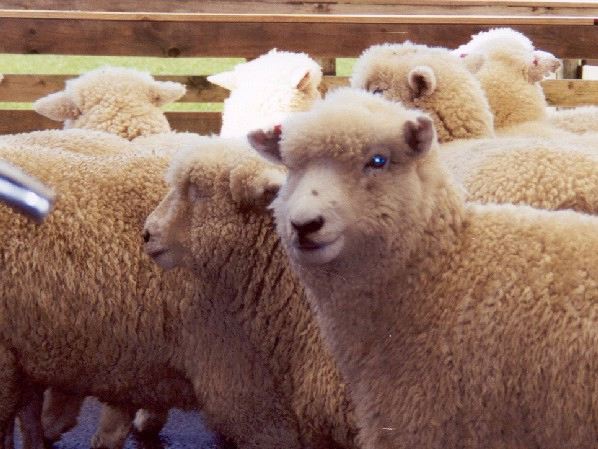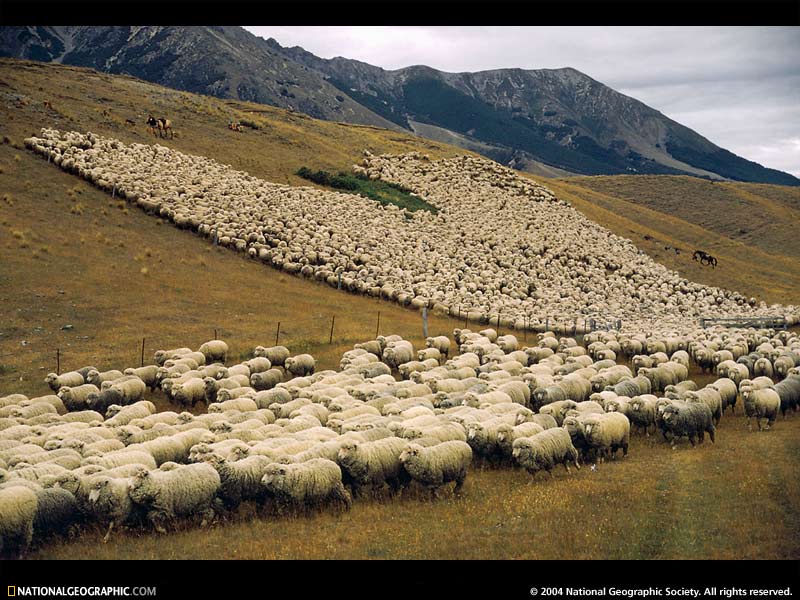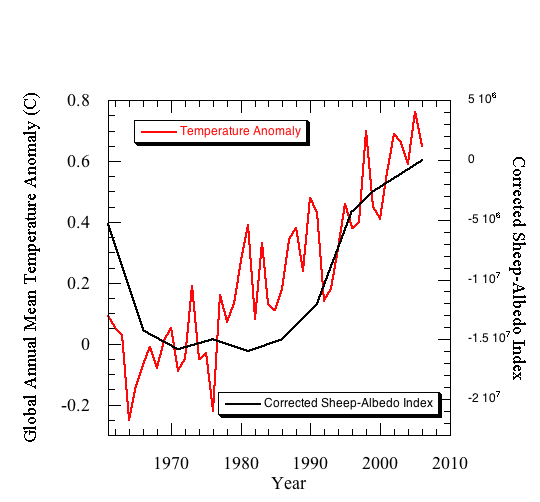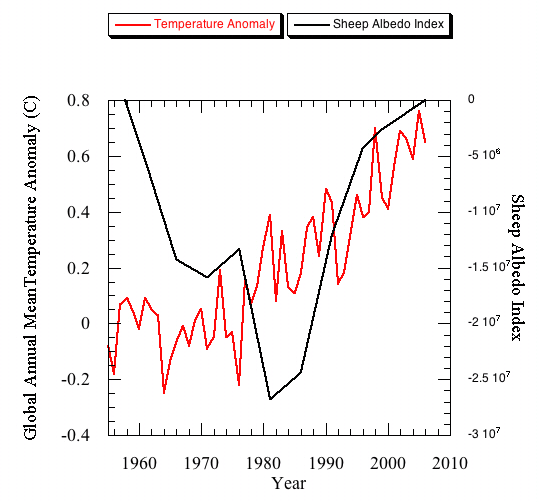
The hypothesis begins with the simple observation that most sheep are white, and therefore have a higher albedo than the land on which they typically graze (see figure below). This effect is confirmed by the recent Sheep Radiation Budget Experiment. The next step in the chain of logic is to note that the sheep population of New Zealand has plummeted in recent years. The resulting decrease in albedo leads to an increase in absorbed Solar radiation, thus warming the planet. The Sheep Albedo hypothesis draws some inspiration from the earlier work of Squeak and Diddlesworth [2] on the effect of the ptarmigan population on the energy balance of the Laurentide ice sheet. Noh-Watt hastens to emphasize that the two hypotheses are quite distinct, since the species of ptarmigan involved in the Squeak-Diddlesworth effect is now extinct.
The proof of the pudding is in the data, shown in the Figure below. Here, the Sheep Albedo Index is defined as the New Zealand Sheep population in each year, subtracted from the 2007 population. The index is defined that way because fewer sheep means lower albedo, and thus a positive radiative forcing. It can be seen that the recent warming can be explained entirely by the decline in the New Zealand sheep population, without any need to bring in any mysterious so-called "radiative forcing" from carbon dioxide, which doesn’t affect the sunlight (hardly) anyway — unlike Sheep Albedo. Some researchers have expressed surprise at the large effect from the relatively small radiative forcing attributable to New Zealand Sheep, or indeed to New Zealand as a whole. "This only shows the fallacy of the concept of Radiative Forcing, which is after all only a theory, not a fact," says Noh-Watt. "Evidently there are amplifying feedbacks at work which give the Sheep Albedo Index a disproportionate influence over climate."
"A real breakthrough was using the statistical technique pioneered by Frusen-Glädje and Haagendassen in their study of the solar-climate connection." said Noh-Watt "Just as in their case, to get a good match to the observed climate, we had to optimize our smoothing algorithm by smoothing some parts of the sheep record more than others, and then rescaling the results." The optimized smoothing was applied to the years 1975-1991. Noted skeptic Rasmus Benestad has criticized this technique as meaningless curve-bashing (see footnote [3] below), but according to Noh-Watt, " All these guys are interested in is getting rich by riding their bicycles to work and selling carbon credits to the EU."
Not everybody agrees with the Sheep Albedo Hypothesis. Leading the flock of skeptics is the New Zealand Sheep Farmers Guild. Their spokesman, Steve Ramsturf (no relation) was quoted as saying "Baaah, Humbug. No matter what goes wrong with the world, they’re always trying to blame the poor New Zealand Sheep Farmer. First it was the methane belch tax. Now this Albedo thing. "
The recognition of the role of sheep albedo opens up some fascinating new possibilities for climate change mechanisms. There is in fact an important destabilizing feedback in the system: as climate gets warmer, there is less demand for wool sweaters and wooly underwear. Hence the sheep population tends to drop, leading to even more warming. In an extreme form, this can lead to a "runaway sheep-albedo feedback," which is believed to have led to the present torrid climate of Venus. Most researchers do not think this could happen on Earth, though. In fact, Oprah and Averell Chanteur, authors of the popular "Unstoppable" series (soon to be a major motion picture) say that the warming will usher in a new era of peace and prosperity, with less enslavement of domestic wool-bearing animals. The hypothesis is laid out in their forthcoming book, "Unstoppable Sheep, every five or six days," which expands on earlier popular titles in the series, such as "Unstoppable daylight, every 42 hours," "Unstoppable Summer, every 17 months, " and the ever-popular autobiographical work "Unstoppable nonsense, every two or three years."
However, Dirk Blitzen, noted researcher from Hogwartz Institute of Technology, has proposed an additional wrinkle on the sheep-albedo idea, which he calls the "sheep-Iris effect" (see Dasher et al. [4] for details). According to Blitzen, a reanalysis of Landsat images shows that as the climate gets warmer, sheep tend to huddle together less. Since wool has a lower emissivity than bare ground, the lack of huddling allows more infrared emission to escape from the ground, cooling the planet and stabilizing its climate. "Frankly, I don’t see how the climate can change much at all," stated Blitzen in recent testimony before the House of Lords, "To be honest, at this point I have a little trouble figuring out how there can even be summer and winter. In the end, I think it will turn out to be a problem with the data." Ozark Junior College satellite expert Jhon Chrystal agrees; his new analysis of MSU satellite data in fact casts doubt on the "consensus" that summer and winter have different temperatures.
But the sheep story may not be as simple as it seems. Hendreck Svampmark of the Danish Institute for Solar-Sheep Interactions notes that at the same time the number of sheep has been going down, the number of cows (which have a lower albedo than sheep) has been going up. "We believe that what is really behind it all are Galactic Cowsmic Rays, which are transmuting sheep DNA into cow DNA." Svampmark hypothesizes a currently undetected particle flux, which he calls "Cowsmic," because there is no observed trend in any of the better-known components of the Galactic Cosmic Ray flux. "We are trying to get money to put sheep in dark-matter accelerators to test our hypothesis, but there’s a hold-up with PETA. It’s all a big conspiracy to protect the consensus, I say."
Footnotes:
[1] Noh-Watt, Ewe "Sheep-Albedo Feedback: A paradigm shift for climate change science." To be submitted to Readers’ Digest, "Humor in Uniform" section.
[2] Squeak, P.P. & Diddlesworth, I.R. 1987. The influence of ptarmigan population dynamics on the thermal regime of the Laurentide Ice Sheet : the surface boundary condition. In eds Edwin D. Waddington & Joseph S. Walder, The Physical Basis of Ice Sheet Modelling (Proceedings of a symposium held during the XIX Assembly of the International Union of Geodesy and Geophysics at Vancouver, August 1987), p.381-384.
[3] Benestad, a well-known spoilsport, points out that without the "optimized" smoothing out of the sheep-albedo-dip in the 1970’s, the correlation breaks down; it breaks down further if one looks at the pre-1966 record. His unprocessed version of the data is shown below:
[4] Dasher ON., Dantzer ON, Prantzer ON, Vixen ON, Comet ON, Cupid ON Donner . , and Blitzen, D.R , (2007) "Why does Rudolf’s nose glow so bright? Infrared effects of mammalian herd behavior." Bull. Tromsø Inst. Reindeer Husbandry



Problem solved. Mutton anyone? :)
Be careful…..you know that Melanie Phillips, Phillip Stott, Monckton and other famous scientists will all be using this in their next op-eds.
What a cheery thing for a Sunday morning. Thank you.
My compliments on what I can only assume is a fine example of rapier sharp analysis!
Do you suppose Ian Helmut is responsible?
Meanwhile, former vice president All Gory has effectively refuted the sheep-albeod hypothesis with an academy-award winning documentary based on his “Hannibal Lecture.” The film, “Silence of the Lambs,” has spun more yarn than any documentary in history.
Oh, you climate scientists really have been pulling the wool over our eyes!
It’s putting mutton on the barbie that’s the big problem, as today’s Mail on Sunday (UK) reported:
Council inspectors to demand £5 ‘carbon offset’ for barbecues
By APRIL BADDELY-BURNS –
It is one of the timeless rituals of the new globally-warmed great British summer: firing up the barbecue and slinging on a steak.
But people who choose to burn charcoal may have to think twice – as councils now have swinging new powers to force homeowners to buy ‘carbon offsets’ before they light up or face a £50 fine.
[edit]
Sign our petition here: ‘We say NO to the garden snoopers’
Ridiculous! Eighty percent of the factors affecting sheep population dynamics are not understood.
These results agree with the work of the late
great I.P. Mypants, which cites the mass of
growing stockpiles of National Graphic back
issues as a threat to the continued spin of the
Earth on its axis.
Indubitably, a tippling point.
Cheers!
But how about black sheeps???
I am the black sheep of my family. I warm the planet by increasing the lavaflows ! Or something.
Ray, are you pulling the fleece over our troposphere or is this another example you scientists doing it to US flock of taxpayers?
In related news:
http://ars.userfriendly.org/cartoons/?id=20070401
A fine satire indeed! But, what do I tell the non-specialists who wonder if they should no longer pursue temperate zone carbon sequestration in forests because “albedo differences cancel out atmospheric CO2 differences, according to the Livermore folks”? I cannot seem to come up with either enought information on the model application (e.g., what are albedo values for forests [all forests?] and grass/shrublands [all grass/shrublands in all growing seasons?])or an educated review of the assumptions made in this set of model experiments. Help! (seriously, folks!).
Al Solomon
On April 1st, those who believe what they read will end up feeling sheepish.
Luckily there are only few black sheeps. And now i finally understand what is wrong with them.
Ewe has got to be kidding!
#8 Precisely, the existence of black sheeps wonderfully fit the new theory, alternate black-and-white dominance in sheep populations explaining most of the so-called “natural variability” of climate. That’s why there’s another implication Raypierre forgot with this ground-breaking hypothesis: a robust explanation of the famous Medieval Optimum.
It is very likely (>90%) that Viking sheep populations initiated a decadal-to-centennal circulation change on Northern latitudes, first a warming phase (because there was probably a majority of black sheeps in the initial population, behaving as perfect four-legs black bodies re-emitting the solar radiation they fully capture), then a cooling phase (because black sheeps were probably killed by hyperthermia, so the white individuals got an adaptative advantage over them, and the sheep albedo effect strongly enhanced the re-glaciation of Greenland and all peri-arctic zone). IMO, the match is perfect, the case is closed, we must now urgently send 5 or 6 billions of white sheeps in the higher troposphere in order to stabilize climate and prevent any dangerous change in the next millenia.
It doesn’t matter. Volcanoes produce more wool annually than sheep do.
Thanks for a great story- your wool-climate feedback loop is equivalent to my “furst” article on this topic arguing that the historic fur trade may have been a driver for climate change: the Europeans wanted to stay warm, hunted down the beavers, the eradication of the beavers led to the disappearance of beaver ponds and that led to a greatly diminished methane flux, et voila – the Little Ice Age was born (Eos, 87, #53, 26 December, 2006). I may need the help of Dr. Frusen-Gladje to get the statistics right on that one.
Joop Varekamp, Wesleyan University, CT
Baa Humbug!
Hilarious Ray. Problem solved, but sheep are especially tough on streams so the affect on water quality is steep.
So realclimate has finally gone completely insane..
Yowza.
(Comment applies to both the article and the preceding comments.)
I’m amazed this made it through peer review. It’s little more than a subtle reworking of the 1977 thesis by BoPeep & Lamb, which gained great traction amongst the climate science community at the time but was completely discredited when a rigorous analysis of frozen sheep dropping cores proved conclusively that temperature rise preceded sheep population decline by some 800 days.
Re: #25, “So realclimate has finally gone completely insane..”
Ummm, dude, look at the date…
@ Stephen Berg
got you twice!?!
oh, please, please, please leave this on the site. please. don’t break my link….
[Response: Don’t worry, we will. -eric]
If you’d like to, er, ruminate over this whole process, there’s a flash animation here. For ‘Daisy’ imagine instead a sheep:
http://library.thinkquest.org/C003763/flash/gaia1.htm
Ray, you have inspired me to resurrect my own closely related “Ewe-nified Theory of Climate”. The warming of Pluto still presents a challenge to this framework, admittedly.
[Response: Isaac, I hope your treatment incorporates some of the recently discussed second order terms that are ignored in the linear theory discussed here, and which are necessary to support Lamb waves. -mike]
What’s the date today again? April 1st, right? Good to see you have a healthy sense of humour; it gives your work and this website even more credibility.
This subject is far too serious to be taken in this light-hearted way. Anyone with the least knowledge of the causes of global warming knows that sheep lanolin (a particularly adhesive substance which is washed from sheep’s wool) is a very potent greenhouse oil. Spreading from the sewers to the surface of the ocean, it reduces wave action, making stilling wells over-read, reducing the mechanical mixing necessary to pull down CO2 (and, by leaving the surface layer poorly mixed, also leading to anomolously high SSTs). Wave entrainment is less, particulate production is lowered and cloud formation over the polluted ocean falls — leading to lower albedos and to more warming. Upwelling suffers because of reduced evaporation and so nutrient levels fall. The last encourages C4 metabolism in phytoplankton and fools the world’s scientists into thinking that the change in isotopic concentrations is anthropogenic rather caused than by reduced fractionation by C4 plants raining out the heavier isotopes to the deep sea ooze.
There is no part of global warming which cannot be explained by lanolin. Or maybe oil spills. Or surfactants. I forget which.
JF
http://www.floodsclimbers.co.uk for the TRUE cause of global warming. (To save time, it’s oil spills)
Nice first april joke
The situation is not that critical, one would think ;-)
But still, how many sheeps to be need, to have an significant effect? ;-)
But we don’t have to forget – the sheeps are emitting CO2 and they also eat the grass! :-D
Maybe we should paint all the building, animals and trees :-D
The brigther colour we use, the better!! :-)
RE # 33, Julian, that is your opinion.
Where did you get your information? Do you trust that information? And, lacking scientific consensus on your belief, how can government leaders propose a cap and trade program to mitigate sheep lanolin effluent?
Was this shear reviewed?
New Zealand lamb chops have always tasted better than their counterparts in other places of the world. Now I know why.
Re 37: a consensus of scientist* at Lodge Farm Cottage is adamant that the ocean surface pollution hypothesis explains everything.
Deniers claim that warming is caused by the insulating property of sheeps’ coverings but — wait for it, wait for it — they’re just trying to pull the wool over your eyes.
JF
*A level, 1964…
(Joking aside, I do wonder about stilling wells.)
How about the offsetting effects of the “bald guy” albedo phenomenon? Was that accounted for? Now that more people are living longer the planet has more bald guys reflecting radiation back into space. Surely that is more than enough to compensate for the increased aborption resulting from fewer sheep.
#10 Surely you know science has shown that if all the National Geographics stored in attics around the country were disposed of, the continent would be 6″ higher, obviously compounding the effects of warming.
No doubt a few eyes will water in the US administration, when they learn how to make a U turn on Global Warming.
Wrong! White sheep leave black pellets behind them, net effect is zero! Black sheep absorb the extra heat, thereby needing somewhat less food and leaving fewer black pellets behind them.
Enough woolgathering! Back to controversy and despair.
This research would also seem to confirm the canniness (that’s Scots for cleverness, I think)of collie dogs, whose job is to look after sheep. Just consider, collies are both black and white so whatever the future holds, whether global warming or the next ice age, they can argue that they are necessary. I reckon collie dogs are set to take over the world.
I knew Ray’s NZ trip would pay a dividend (he was even on the radio, folks)…
However, spending all his time with our modelling community he missed out on some of the shearing-edge research being conducted by the New Zealand Wool Board and the Wine Institute – code-named the vin de mouton project. Under normal conditions, turning an old sheep paddock into a vineyard would be a climate “double whammy” – loss of sheep albedo effect made worse by the heat-absorbing canopy of a growing vineyard (see here for an example).
The research programme began by exploring the concept of “wool offsets”, where vineyards could purchase sheep in other parts of the country to offset their warming effect, but it quickly became obvious that this would be difficult to monitor and implement. Sheep on south-facing slopes, for instance, have a much lower albedo effect than those on north-facing slopes (remember, this is the southern hemisphere). Trials with GPS monitoring of sheep movements in rolling hill country did show that the animals do seek out sunnier spots on colder days, but this was affected by fleece length (more fleece, less need for external heat) and by the animals’ need for shade in hot weather.
Recent work has established that the only way to make the wool offset concept work is to apply it at the vineyard level. Each vineyard maintains its own flock of sheep (about one sheep to 100 vines), and they are grazed between the vines at regular intervals – good for weed control and fertilisation, though they do have a tendency to like vine leaves (especially sheep with Greek bloodlines). This can be overcome by timing the application of sheep to the vineyard so that they animals can assist with leaf pruning to expose grape bunches to sunlight. The sheep are also fed all the prunings, and early results indicate that this diet significantly reduces the methane produced compared with an all-grass diet. Feed the sheep the grape skins left after the fruit is crushed for wine-making, and the sheepmeat develops a wonderful dark colour and marvellous flavours. Vine-fed lamb is expected to begin trial marketing soon, and it is expected to be a hit with gourmets in all our export markets (except, possibly, France).
The effect of sheep on wine quality is however a little more problematic. The flavour of sauvignon blanc – NZ’s flagship varietal – has been likened to “cat’s pee on a gooseberry bush”, and with overuse of wool offsets this can be a little more like “ram’s pee on a blackcurrant bush”. Trials with different breeds are continuing, and currently it looks as though merinos are the most benign on the basis of final bouquet.
Perhaps when Ray returns, I might induce him to join in the taste-testing process?
I think I’ve been taken for a shearing…
I’m disappointed. This article is far too alambist.
By the way, I’ve heard that Channel 4 is commissioning a new documentary promoting this hypothesis. It is to be called “The Great Global Warming Spindle.”